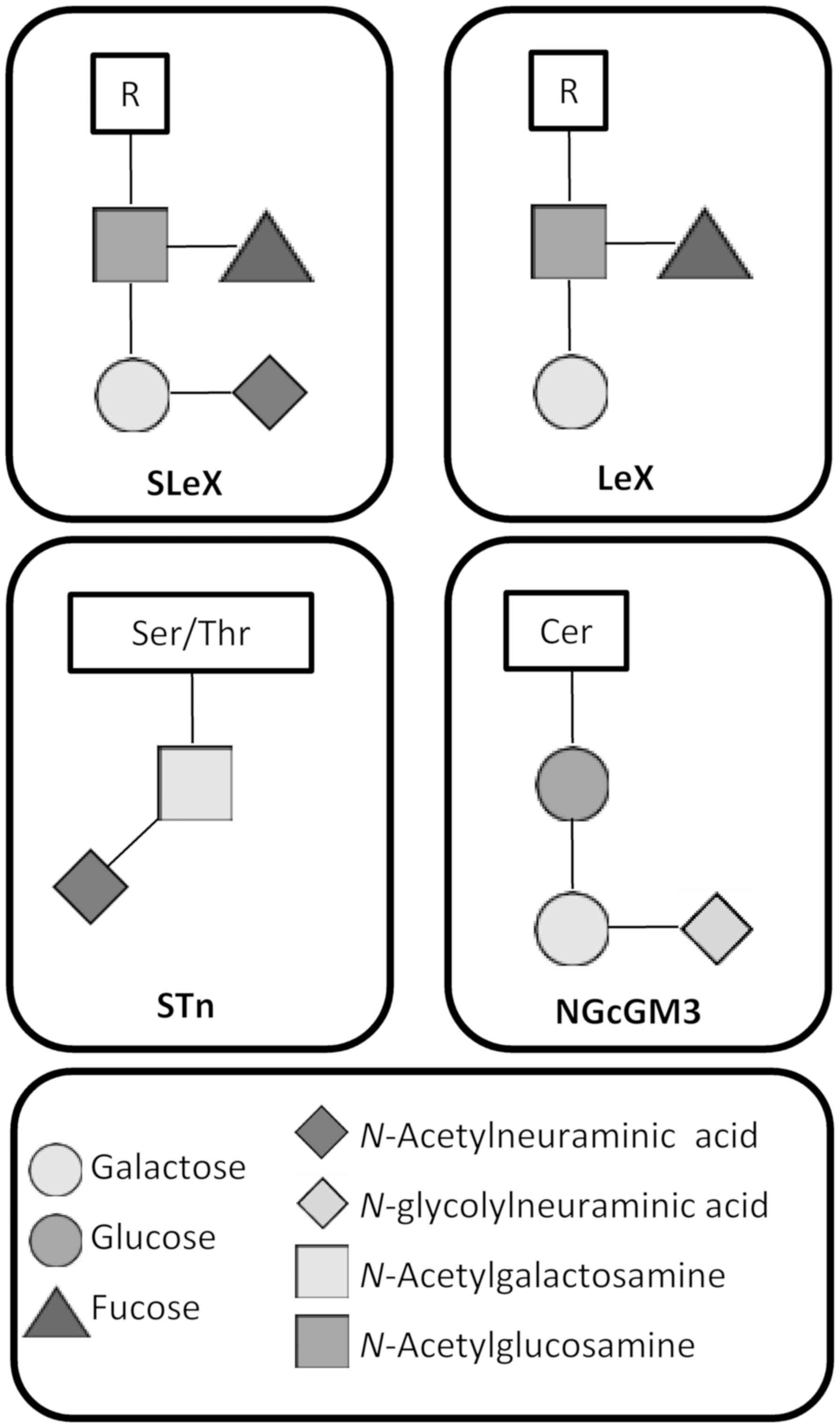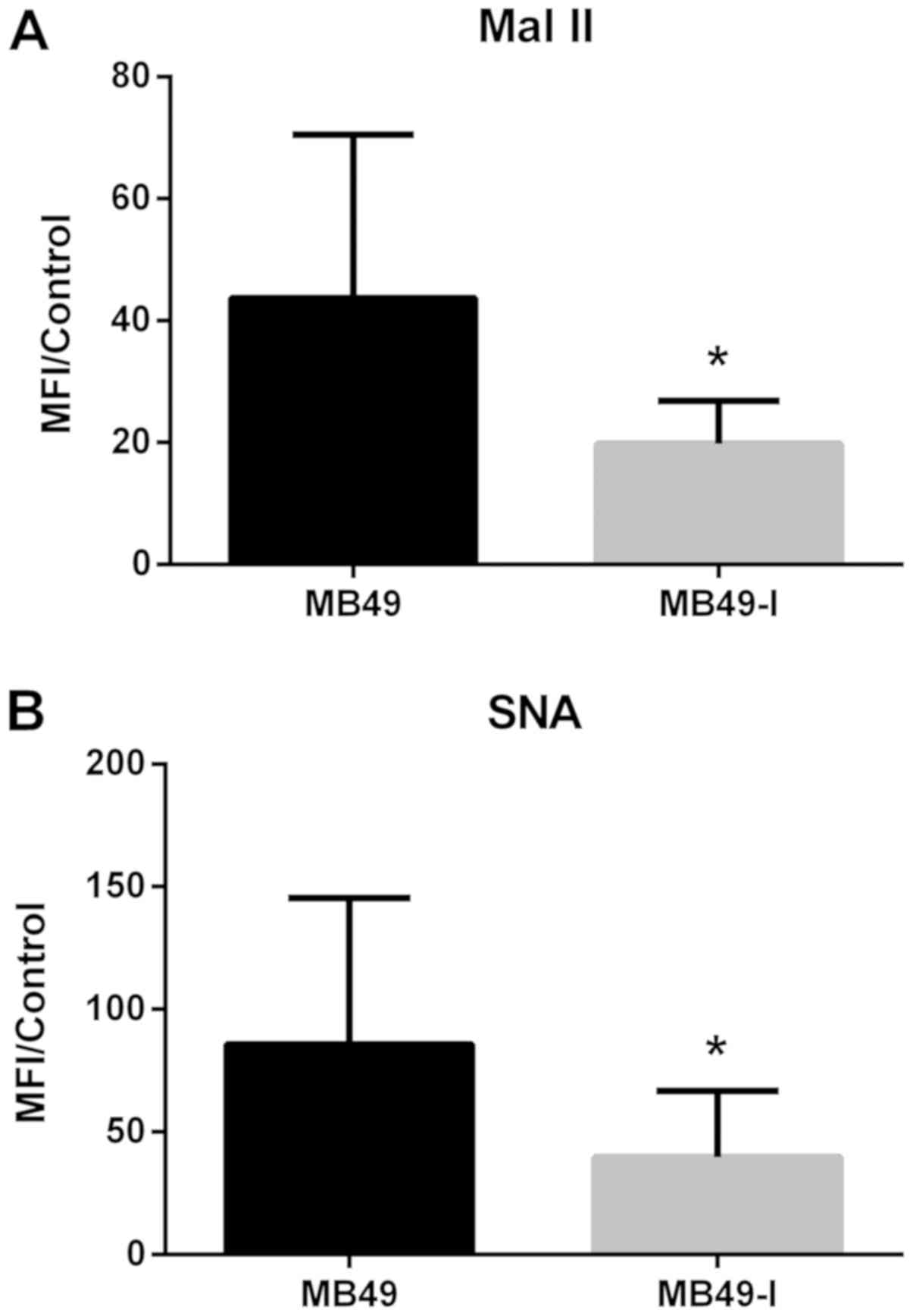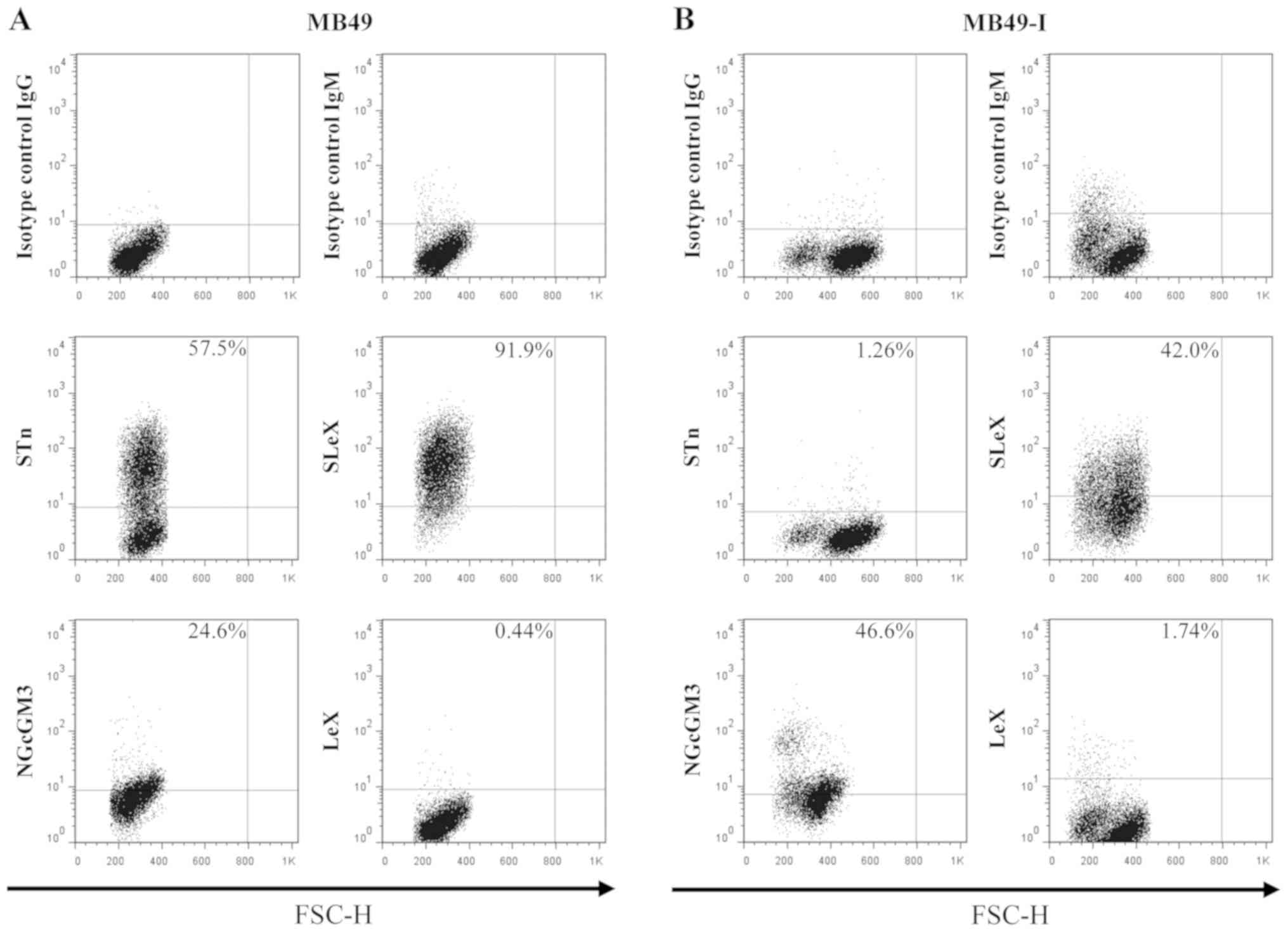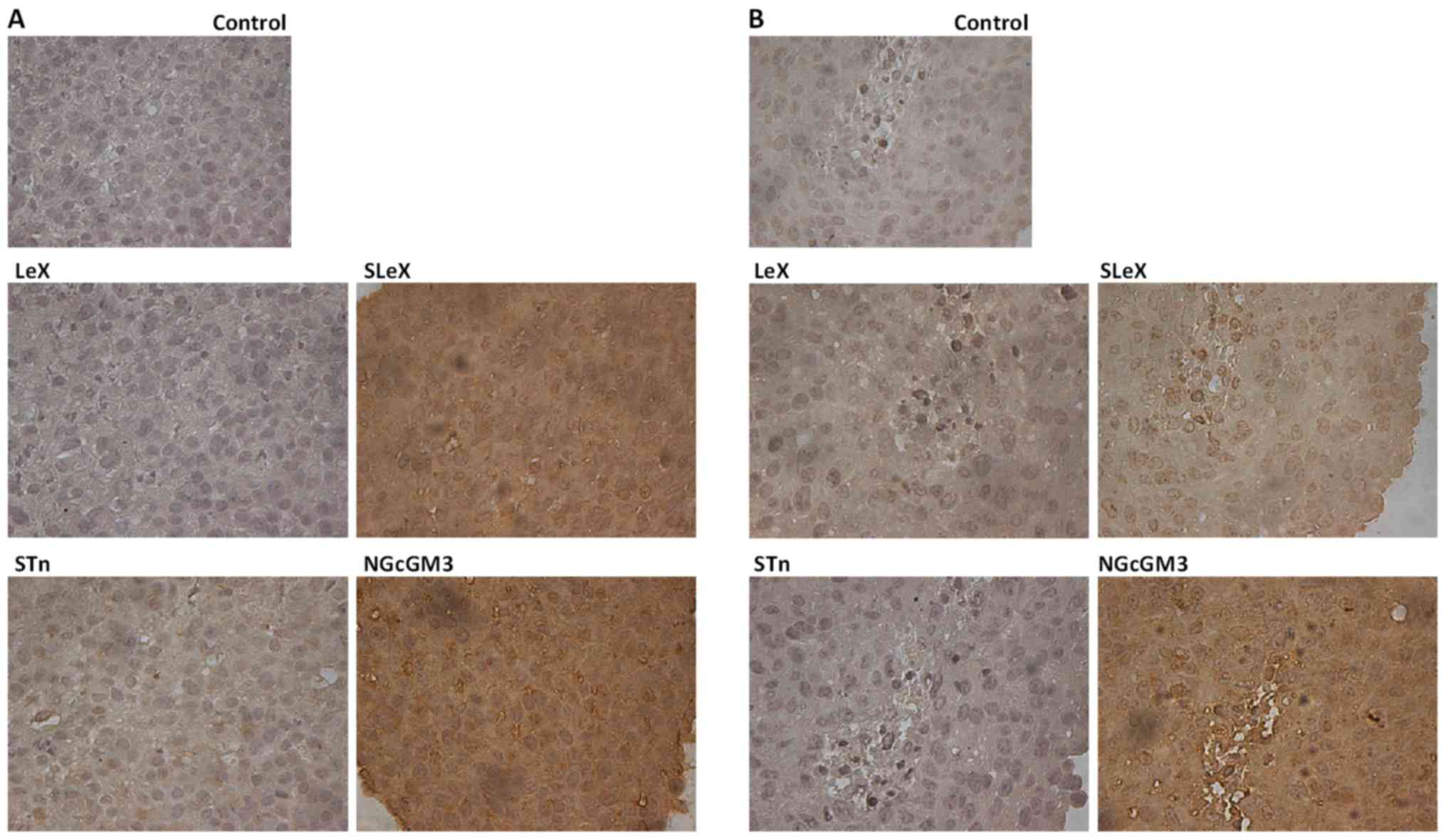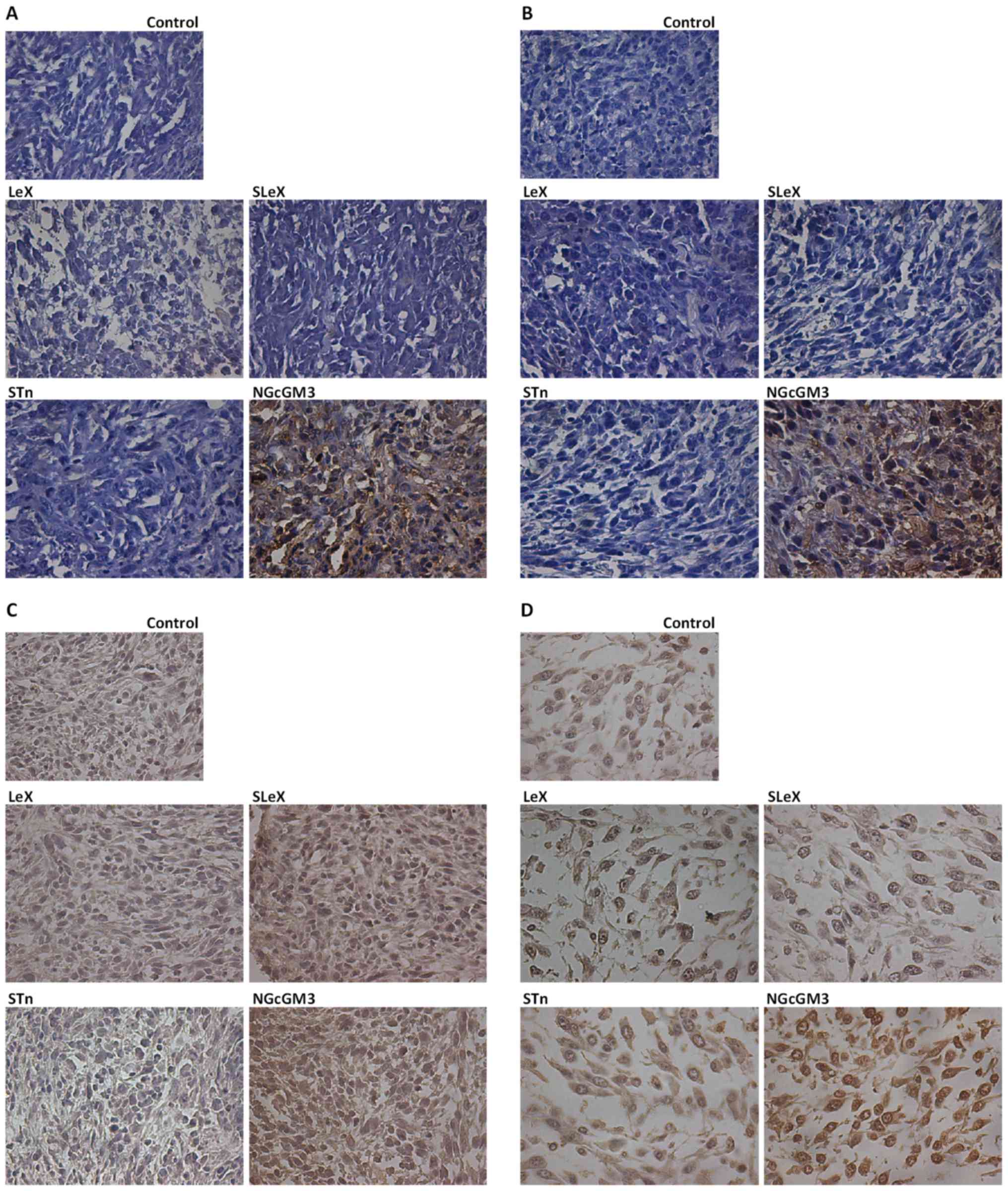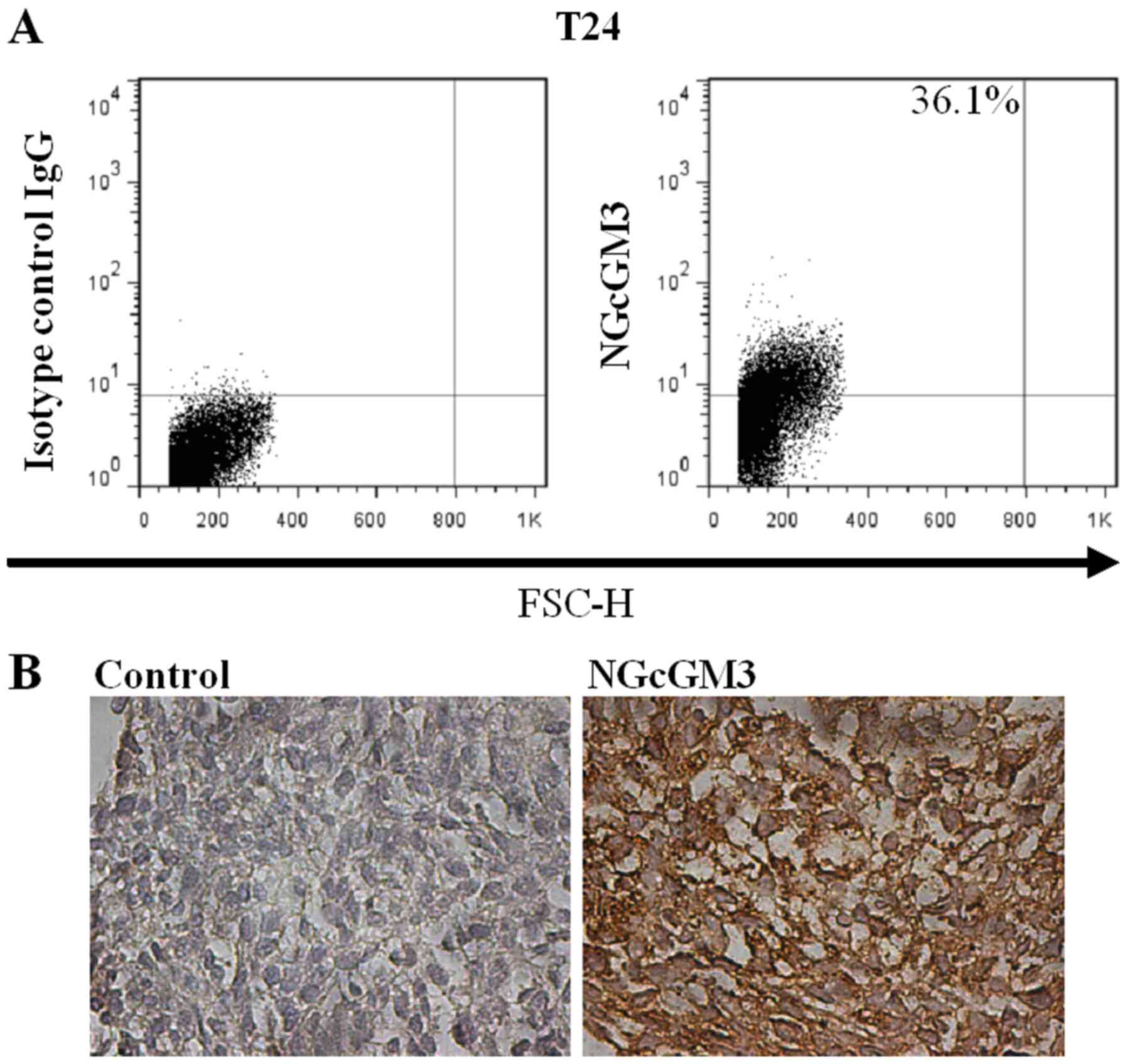|
1
|
Bray F, Ren JS, Masuyer E and Ferlay J:
Global estimates of cancer prevalence for 27 sites in the adult
population in 2008. Int J Cancer. 132:1133–1145. 2013. View Article : Google Scholar : PubMed/NCBI
|
|
2
|
Kirkali Z, Chan T, Manoharan M, Algaba F,
Busch C, Cheng L, Kiemeney L, Kriegmair M, Montironi R, Murphy WM,
et al: Bladder cancer: Epidemiology, staging and grading, and
diagnosis. Urology. 66 (6 Suppl 1):S4–S34. 2005. View Article : Google Scholar
|
|
3
|
Huang BW and Gao JQ: Application of 3D
cultured multicellular spheroid tumor models in tumor-targeted drug
delivery system research. J Control Release. 270:246–259. 2018.
View Article : Google Scholar : PubMed/NCBI
|
|
4
|
Tabayoyong W and Gao J: The emerging role
of immunotherapy in advanced urothelial cancers. Curr Opin Oncol.
30:172–180. 2018.PubMed/NCBI
|
|
5
|
Nadal R and Apolo AB: Overview of current
and future adjuvant therapy for muscle-invasive urothelial
carcinoma. Curr Treat Options Oncol. 19:362018. View Article : Google Scholar : PubMed/NCBI
|
|
6
|
Redelman-Sidi G, Glickman MS and Bochner
BH: The mechanism of action of BCG therapy for bladder cancer-a
current perspective. Nat Rev Urol. 11:153–162. 2014. View Article : Google Scholar : PubMed/NCBI
|
|
7
|
Bladder Cancer Treatment
(PDQ®): Health Professional Version: PDQ cancer
information summaries. Bethesda (MD): 2002
|
|
8
|
Rouanne M, Loriot Y, Lebret T and Soria
JC: Novel therapeutic targets in advanced urothelial carcinoma.
Crit Rev Oncol Hematol. 98:106–115. 2016. View Article : Google Scholar : PubMed/NCBI
|
|
9
|
Rouanne M, Roumiguié M, Houédé N,
Masson-Lecomte A, Colin P, Pignot G, Larré S, Xylinas E, Rouprêt M
and Neuzillet Y: Development of immunotherapy in bladder cancer:
Present and future on targeting PD(L)1 and CTLA-4 pathways. World J
Urol. 36:1727–1740. 2018. View Article : Google Scholar : PubMed/NCBI
|
|
10
|
Kobayashi T, Owczarek TB, McKiernan JM and
Abate-Shen C: Modelling bladder cancer in mice: Opportunities and
challenges. Nat Rev Cancer. 15:42–54. 2015. View Article : Google Scholar : PubMed/NCBI
|
|
11
|
Smolensky D, Rathore K and Cekanova M:
Molecular targets in urothelial cancer: Detection, treatment, and
animal models of bladder cancer. Drug Des Devel Ther. 10:3305–3322.
2016. View Article : Google Scholar : PubMed/NCBI
|
|
12
|
Zhang N, Li D, Shao J and Wang X: Animal
models for bladder cancer: The model establishment and evaluation
(Review). Oncol Lett. 9:1515–1519. 2015. View Article : Google Scholar : PubMed/NCBI
|
|
13
|
Summerhayes IC and Franks LM: Effects of
donor age on neoplastic transformation of adult mouse bladder
epithelium in vitro. J Natl Cancer Inst. 62:1017–1023.
1979.PubMed/NCBI
|
|
14
|
Chan E, Patel A, Heston W and Larchian W:
Mouse orthotopic models for bladder cancer research. BJU Int.
104:1286–1291. 2009. View Article : Google Scholar : PubMed/NCBI
|
|
15
|
De Boer EC, Teppema JS, Steerenberg PA and
De Jong WH: Retrovirus type C in the mouse bladder carcinoma cell
line MBT-2. J Urol. 163:1999–2001. 2000. View Article : Google Scholar : PubMed/NCBI
|
|
16
|
Kasman L and Voelkel-Johnson C: An
orthotopic bladder cancer model for gene delivery studies. J Vis
Exp. 501812013.PubMed/NCBI
|
|
17
|
Lodillinsky C, Rodriguez V, Vauthay L,
Sandes E, Casabé A and Eiján AM: Novel invasive orthotopic bladder
cancer model with high cathepsin B activity resembling human
bladder cancer. J Urol. 182:749–755. 2009. View Article : Google Scholar : PubMed/NCBI
|
|
18
|
Chen F, Zhang G, Cao Y, Hessner MJ and See
WA: MB49 murine urothelial carcinoma: Molecular and phenotypic
comparison to human cell lines as a model of the direct tumor
response to bacillus Calmette-Guerin. J Urol. 182:2932–2937. 2009.
View Article : Google Scholar : PubMed/NCBI
|
|
19
|
Fabris VT, Lodillinsky C, Pampena MB,
Belgorosky D, Lanari C and Eiján AM: Cytogenetic characterization
of the murine bladder cancer model MB49 and the derived invasive
line MB49-I. Cancer Genet. 205:168–176. 2012. View Article : Google Scholar : PubMed/NCBI
|
|
20
|
Varki A, Kannagi R, Toole B and Stanley P:
Glycosylation Changes in Cancer. rd, Varki A, Cummings RD, Esko JD,
Stanley P, Hart GW, et al: Essentials of Glycobiology. Cold Spring
Harbor. ((NY)). pp597–609. 2015.
|
|
21
|
Vajaria BN and Patel PS: Glycosylation: A
hallmark of cancer? Glycoconj J. 34:147–156. 2017. View Article : Google Scholar : PubMed/NCBI
|
|
22
|
Pinho SS and Reis CA: Glycosylation in
cancer: Mechanisms and clinical implications. Nat Rev Cancer.
15:540–555. 2015. View
Article : Google Scholar : PubMed/NCBI
|
|
23
|
Pearce OMT: Cancer glycan epitopes:
Biosynthesis, structure and function. Glycobiology. 28:670–696.
2018. View Article : Google Scholar : PubMed/NCBI
|
|
24
|
Tuccillo FM, de Laurentiis A, Palmieri C,
Fiume G, Bonelli P, Borrelli A, Tassone P, Scala I, Buonaguro FM,
Quinto I and Scala G: Aberrant glycosylation as biomarker for
cancer: Focus on CD43. Biomed Res Int. 2014:7428312014. View Article : Google Scholar : PubMed/NCBI
|
|
25
|
Heimburg-Molinaro J, Lum M, Vijay G, Jain
M, Almogren A and Rittenhouse-Olson K: Cancer vaccines and
carbohydrate epitopes. Vaccine. 29:8802–8826. 2011. View Article : Google Scholar : PubMed/NCBI
|
|
26
|
Rabu C, McIntosh R, Jurasova Z and Durrant
L: Glycans as targets for therapeutic antitumor antibodies. Future
Oncol. 8:943–960. 2012. View Article : Google Scholar : PubMed/NCBI
|
|
27
|
Segatori VI, Otero LL, Fernandez LE, Gomez
DE, Alonso DF and Gabri MR: Antitumor protection by NGcGM3/VSSP
vaccine against transfected B16 mouse melanoma cells overexpressing
N-glycolylated gangliosides. In Vivo. 26:609–617. 2012.PubMed/NCBI
|
|
28
|
Segatori VI, Vazquez AM, Gomez DE, Gabri
MR and Alonso DF: Preclinical evaluation of racotumomab, an
anti-idiotype monoclonal antibody to N-glycolyl-containing
gangliosides, with or without chemotherapy in a mouse model of
non-small cell lung cancer. Front Oncol. 2:1602012. View Article : Google Scholar : PubMed/NCBI
|
|
29
|
Steentoft C, Migliorini D, King TR, Mandel
U, June CH and Posey AD Jr: Glycan-directed CAR-T cells.
Glycobiology. 28:656–669. 2018. View Article : Google Scholar : PubMed/NCBI
|
|
30
|
Ohyama C: Glycosylation in bladder cancer.
Int J Clin Oncol. 13:308–313. 2008. View Article : Google Scholar : PubMed/NCBI
|
|
31
|
Parker J and Spiess PE: Current and
emerging bladder cancer urinary biomarkers. ScientificWorldJournal.
11:1103–1112. 2011. View Article : Google Scholar : PubMed/NCBI
|
|
32
|
Dal Moro F, Valotto C, Guttilla A and
Zattoni F: Urinary markers in the everyday diagnosis of bladder
cancer. Urologia. 80:265–275. 2013. View Article : Google Scholar : PubMed/NCBI
|
|
33
|
Burchardt M, Burchardt T, Shabsigh A, De
La Taille A, Benson MC and Sawczuk I: Current concepts in biomarker
technology for bladder cancers. Clin Chem. 46:595–605.
2000.PubMed/NCBI
|
|
34
|
Fujii Y, Yoshida M, Chien LJ, Kihara K,
Kageyama Y, Yasukochi Y and Oshima H: Significance of carbohydrate
antigen sialyl-Lewis X, sialyl-Lewis A, and possible unknown
ligands to adhesion of human urothelial cancer cells to activated
endothelium. Urol Int. 64:129–133. 2000. View Article : Google Scholar : PubMed/NCBI
|
|
35
|
Numahata K, Satoh M, Handa K, Saito S,
Ohyama C, Ito A, Takahashi T, Hoshi S, Orikasa S and Hakomori SI:
Sialosyl-Le(x) expression defines invasive and metastatic
properties of bladder carcinoma. Cancer. 94:673–685. 2002.
View Article : Google Scholar : PubMed/NCBI
|
|
36
|
Lima L, Neves M, Oliveira MI, Dieguez L,
Freitas R, Azevedo R, Gaiteiro C, Soares J, Ferreira D, Peixoto A,
et al: Sialyl-Tn identifies muscle-invasive bladder cancer basal
and luminal subtypes facing decreased survival, being expressed by
circulating tumor cells and metastases. Urol Oncol.
35:675.e1–675.e8. 2017. View Article : Google Scholar
|
|
37
|
Cotton S, Azevedo R, Gaiteiro C, Ferreira
D, Lima L, Peixoto A, Fernandes E, Neves M, Neves D, Amaro T, et
al: Targeted O-glycoproteomics explored increased sialylation and
identified MUC16 as a poor prognosis biomarker in advanced-stage
bladder tumours. Mol Oncol. 11:895–912. 2017. View Article : Google Scholar : PubMed/NCBI
|
|
38
|
Peixoto A, Fernandes E, Gaiteiro C, Lima
L, Azevedo R, Soares J, Cotton S, Parreira B, Neves M, Amaro T, et
al: Hypoxia enhances the malignant nature of bladder cancer cells
and concomitantly antagonizes protein O-glycosylation extension.
Oncotarget. 7:63138–63157. 2016. View Article : Google Scholar : PubMed/NCBI
|
|
39
|
Severino PF, Silva M, Carrascal M,
Malagolini N, Chiricolo M, Venturi G, Astolfi A, Catera M, Videira
PA and Dall'Olio F: Expression of sialyl-Tn sugar antigen in
bladder cancer cells affects response to Bacillus Calmette Guérin
(BCG) and to oxidative damage. Oncotarget. 8:54506–54517. 2017.
View Article : Google Scholar : PubMed/NCBI
|
|
40
|
Scursoni AM, Galluzzo L, Camarero S, Lopez
J, Lubieniecki F, Sampor C, Segatori VI, Gabri MR, Alonso DF,
Chantada G and de Dávila MT: Detection of N-glycolyl GM3
ganglioside in neuroectodermal tumors by immunohistochemistry: An
attractive vaccine target for aggressive pediatric cancer. Clin Dev
Immunol. 2011:2451812011. View Article : Google Scholar : PubMed/NCBI
|
|
41
|
Malykh YN, Schauer R and Shaw L:
N-Glycolylneuraminic acid in human tumours. Biochimie. 83:623–634.
2001. View Article : Google Scholar : PubMed/NCBI
|
|
42
|
Carr A, Mullet A, Mazorra Z, Vázquez AM,
Alfonso M, Mesa C, Rengifo E, Pérez R and Fernández LE: A mouse
IgG1 monoclonal antibody specific for N-glycolyl GM3 ganglioside
recognized breast and melanoma tumors. Hybridoma. 19:241–247. 2000.
View Article : Google Scholar : PubMed/NCBI
|
|
43
|
van Cruijsen H, Ruiz MG, van der Valk P,
de Gruijl TD and Giaccone G: Tissue micro array analysis of
ganglioside N-glycolyl GM3 expression and signal transducer and
activator of transcription (STAT)-3 activation in relation to
dendritic cell infiltration and microvessel density in non-small
cell lung cancer. BMC Cancer. 9:1802009. View Article : Google Scholar : PubMed/NCBI
|
|
44
|
Blanco R, Domínguez E, Morales O, Blanco
D, Martínez D, Rengifo CE, Viada C, Cedeño M, Rengifo E and Carr A:
Prognostic significance of N-Glycolyl GM3 ganglioside expression in
non-small cell lung carcinoma patients: New evidences. Patholog Res
Int. 2015:1323262015.PubMed/NCBI
|
|
45
|
Vázquez AM, Hernández AM, Macías A,
Montero E, Gómez DE, Alonso DF, Gabri MR and Gómez RE: Racotumomab:
An anti-idiotype vaccine related to N-glycolyl-containing
gangliosides-preclinical and clinical data. Front Oncol. 2:1502012.
View Article : Google Scholar : PubMed/NCBI
|
|
46
|
Yuhas JM, Li AP, Martinez AO and Ladman
AJ: A simplified method for production and growth of multicellular
tumor spheroids. Cancer Res. 37:3639–3643. 1977.PubMed/NCBI
|
|
47
|
Ferreira LP, Gaspar VM and Mano JF: Design
of spherically structured 3D in vitro tumor models-Advances and
prospects. Acta Biomaterialia. 75:11–34. 2018. View Article : Google Scholar : PubMed/NCBI
|
|
48
|
Kucinska M, Murias M and Nowak-Sliwinska
P: Beyond mouse cancer models: Three-dimensional human-relevant in
vitro and non-mammalian in vivo models for photodynamic therapy.
Mutat Res. 773:242–262. 2017. View Article : Google Scholar : PubMed/NCBI
|
|
49
|
Lu H and Stenzel MH: Multicellular tumor
spheroids (MCTS) as a 3D in vitro evaluation tool of nanoparticles.
Small. 14:e17028582018. View Article : Google Scholar : PubMed/NCBI
|
|
50
|
Du Q, Jiang L, Wang XQ, Pan W, She FF and
Chen YL: Establishment of and comparison between orthotopic
xenograft and subcutaneous xenograft models of gallbladder
carcinoma. Asian Pac J Cancer Prev. 15:3747–3752. 2014. View Article : Google Scholar : PubMed/NCBI
|
|
51
|
Zhang Y, Zhang GL, Sun X, Cao KX, Ma C,
Nan N, Yang GW, Yu MW and Wang XM: Establishment of a murine breast
tumor model by subcutaneous or orthotopic implantation. Oncol Lett.
15:6233–6240. 2018.PubMed/NCBI
|
|
52
|
Schrauwen S, Coenegrachts L, Depreeuw J,
Luyten C, Verbist G, Debruyne D, Vergote I, Lambrechts D and Amant
F: Microsatellite instable and microsatellite stable primary
endometrial carcinoma cells and their subcutaneous and orthotopic
xenografts recapitulate the characteristics of the corresponding
primary tumor. Int J Gynecol Cancer. 25:363–371. 2015. View Article : Google Scholar : PubMed/NCBI
|
|
53
|
Kajiwara H, Yasuda M, Kumaki N, Shibayama
T and Osamura Y: Expression of carbohydrate antigens (SSEA-1,
sialyl-Lewis X, DU-PAN-2 and CA19-9) and E-selectin in urothelial
carcinoma of the renal pelvis, ureter, and urinary bladder. Tokai J
Exp Clin Med. 30:177–182. 2005.PubMed/NCBI
|
|
54
|
Munkley J: The role of Sialyl-Tn in
cancer. Int J Mol Sci. 17:2752016. View Article : Google Scholar : PubMed/NCBI
|
|
55
|
Ozaki H, Matsuzaki H, Ando H, Kaji H,
Nakanishi H, Ikehara Y and Narimatsu H: Enhancement of metastatic
ability by ectopic expression of ST6GalNAcI on a gastric cancer
cell line in a mouse model. Clin Exp Metastasis. 29:229–238. 2012.
View Article : Google Scholar : PubMed/NCBI
|
|
56
|
Julien S, Adriaenssens E, Ottenberg K,
Furlan A, Courtand G, Vercoutter-Edouart AS, Hanisch FG, Delannoy P
and Le Bourhis X: ST6GalNAc I expression in MDA-MB-231 breast
cancer cells greatly modifies their O-glycosylation pattern and
enhances their tumourigenicity. Glycobiology. 16:54–64. 2006.
View Article : Google Scholar : PubMed/NCBI
|
|
57
|
Clément M, Rocher J, Loirand G and Le
Pendu J: Expression of sialyl-Tn epitopes on beta1 integrin alters
epithelial cell phenotype, proliferation and haptotaxis. J Cell
Sci. 117:5059–5069. 2004. View Article : Google Scholar : PubMed/NCBI
|
|
58
|
Chou HH, Takematsu H, Diaz S, Iber J,
Nickerson E, Wright KL, Muchmore EA, Nelson DL, Warren ST and Varki
A: A mutation in human CMP-sialic acid hydroxylase occurred after
the Homo-Pan divergence. Proc Natl Acad Sci USA. 95:11751–11756.
1998. View Article : Google Scholar : PubMed/NCBI
|
|
59
|
Hayakawa T, Satta Y, Gagneux P, Varki A
and Takahata N: Alu-mediated inactivation of the human
CMP-N-acetylneuraminic acid hydroxylase gene. Proc Natl Acad Sci
USA. 98:11399–11404. 2001. View Article : Google Scholar : PubMed/NCBI
|
|
60
|
Bardor M, Nguyen DH, Diaz S and Varki A:
Mechanism of uptake and incorporation of the non-human sialic acid
N-glycolylneuraminic acid into human cells. J Biol Chem.
280:4228–4237. 2005. View Article : Google Scholar : PubMed/NCBI
|
|
61
|
Yin J, Hashimoto A, Izawa M, Miyazaki K,
Chen GY, Takematsu H, Kozutsumi Y, Suzuki A, Furuhata K, Cheng FL,
et al: Hypoxic culture induces expression of sialin, a sialic acid
transporter, and cancer-associated gangliosides containing
non-human sialic acid on human cancer cells. Cancer Res.
66:2937–2945. 2006. View Article : Google Scholar : PubMed/NCBI
|
|
62
|
Alfonso S, Valdés-Zayas A, Santiesteban
ER, Flores YI, Areces F, Hernández M, Viada CE, Mendoza IC, Guerra
PP, García E, et al: A randomized, multicenter, placebo-controlled
clinical trial of racotumomab-alum vaccine as switch maintenance
therapy in advanced non-small cell lung cancer patients. Clin
Cancer Res. 20:3660–3671. 2014. View Article : Google Scholar : PubMed/NCBI
|
|
63
|
Cacciavillano W, Sampor C, Venier C, Gabri
MR, de Dávila MT, Galluzzo ML, Guthmann MD, Fainboim L, Alonso DF
and Chantada GL: A phase I study of the anti-idiotype vaccine
racotumomab in neuroblastoma and other pediatric refractory
malignancies. Pediatr Blood Cancer. 62:2120–2124. 2015. View Article : Google Scholar : PubMed/NCBI
|



